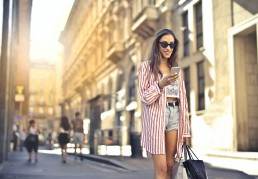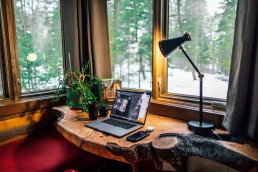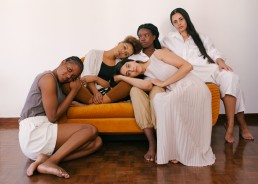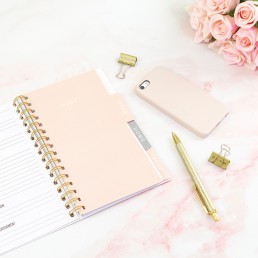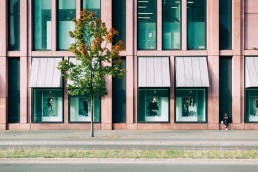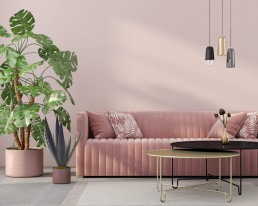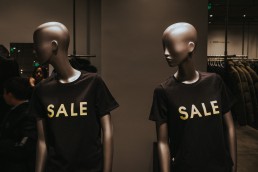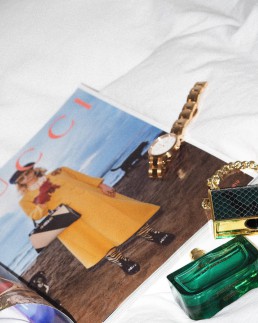Customers in the New Retail Environment
Advances of technology have changed how customers interact with the retail business. This is not news to anyone, but how exactly have the customers changed? This is a very important question to ask ourselves, the answer will guide the strategy of a retail business. Below we present some examples of how they have changed!
They play a new role in a company’s processes
With the increase of data we have a more thorough understanding of how the consumer behaves, from the minute they get on the channel that connects them to the retail business to the end of their experience, for this reason companies are better able to adapt to the consumer’s needs, changing their processes.
Expectations are different and higher!
With all the information available on the Internet, consumers are making way more educated purchases, including going through a process of comparison with other brands. As society becomes more digitized they also expect good experiences in online channels. Nevertheless, that is not to say they don’t need a good in-person experience, they value those experiences even more.
Collaboration and co-creation are becoming more common
Customers want to form part of the ecosystem, and they also value the opinion of their peers online! They value the brand more if they are taking business decisions with them.
Customers have a criteria for user experience (even if they don’t know what it is)
Through studying their decision-making process we can see that users spend less time in apps for companies they have contractual relationships with (think gas, or electricity services), in fact they might even delete the app if they are not convinced. In other words, they know which apps are worth their time, and which are not. It actually mirrors their behavior in physical stores.
My Experience at ELLE Education
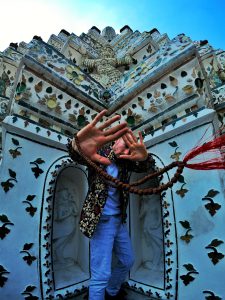
I try to shape and educate myself as much as I can in order to satisfy my never-ending curiosity. I pay a lot of attention to my personal development, mental needs and growth. My personality has many sides that I try to empower through continuous education, so I have studied at several universities. I am a private detective, artist, portrait photographer, genealogist researcher.
I still have ongoing studies in healthcare management, and project management.
The reason why I decided to add ELLE Education's Event Production course to my colourful palette is because I would like to broaden my knowledge of management, to know more about how event production works in connection with fashion. It feeds my artistic side and my future self-managerial goals at the same time. ELLE Education provides a great opportunity to learn from a great tutor and experts. The reading materials are easy to handle and give me so much information that I can perfectly use for my future projects. The best part is that I can have an insight into the work of big names of the industry, like Mauricio Kirschner, Louis Ma, and many other great event producers, designers. I am very grateful for this opportunity.
Thank you ELLE & Mindway
Peter Henrik Gall(Event Production)
A Letter to Our Readers
Today we want to thank you for using our blog to find out career and industry insights! We love to connect with you, and fashion, luxury, and interior design lovers from all over the world.
We created this blog as a way to share all of our knowledge at ELLE Education with everyone, regardless of whether they are prospective students, curious minds, or current students. Our blog speaks with all of you in mind!
We want the world to see the different professional paths in the area of lifestyle. We also want the world to understand our essence as ELLE Education with our content.
Go to Career Insights if you want to know more about certain professions and hear advice from professionals; go to Industry Insights if you want to find out the larger truths of a sector; go to Get to Know ELLE Education if you want to find out more about us.
We are delighted to be closing this academic year with plenty of content to spend the day learning! This is the most important aspect of our blog, our mission; to help you learn from wherever you are and whenever you can.
Thank you again, we hope to keep giving you excellent content to keep your mind curious and running.
Sincerely,
The ELLE Education Team
P.S. If you are a student and would like one of your articles to be featured on our blog, we are only one email away ;)
My Experience at ELLE Education

I’ve always dreamt of working in the fashion sector, and who knows fashion more than ELLE?
That’s the reason why I chose to be part of this program of which I’ve been enjoying every single moment.
Since the first module, I have realised that all the knowledge I was going to acquire was what I have always wanted to learn and, more importantly, what could put me on the front line in this sector.
The fashion industry is changing so fast, trends are faster than ever before, and this means that it is fundamental to keep up and have a much wider knowledge than before in order to be part of the
change.
This diploma course allows you to study whenever and wherever you want, but it is important to underline that you never feel alone because you are part of a community where you can share all your doubts, questions, and info. There is always someone ready to help you and guide you for everything.
There is a saying that goes “stay with the know and not with the don’t know” and this program definitely puts you in the know of marketing for fashion and luxury brands.
I am very grateful to ELLE Education for allowing me this opportunity to be part of their program, I really want to say thank you for this stunning experience I’m going through.
I hope everyone will enjoy the course as much as I do.
Thank you!
Fiamma Reali(Marketing and Communications for Fashion and Luxury Brands)
The Importance of Customer Loyalty in Retail
What makes a retail business survive? The answer is actually quite simple, customer loyalty. Businesses need to have repeating customers who love the brand, especially in today’s highly competitive environment… But what is customer loyalty? It is the link between the customer and the retailer. Why is this important in business terms?
Because Loyal Customers:
-Generate more revenue!
-The expenses related to keeping them tend to be lower than that of attracting new ones.
-Increase the amount they purchase and value the brand as their confidence increases with loyalty management.
-Are the best advocates for the company!
-Give retailers an advantage over their competitors, it’s hard to break the trust!
-Are less sensitive to changes in prices, because they value the brand and are conscious of the value they are receiving through their purchases.
-Are early adopters of the company’s new initiatives, this is great because they can become references for new products!
In all, there are plenty of benefits in terms of revenue, market positioning, marketing, and even strategy. Customer loyalty is one of the most important aspects in business survival in today’s markets. This could be why we have seen a shift towards creating exclusive experiences for customers.
What is the right career for you? (Fashion & Design Edition)
You know that your professional future is in lifestyle, but where exactly? We’ll help you find out with this quiz!
1- What is the first thing you notice in an ad?
a- What the actors are wearing
b- The message of the ad
c- The play of colors and lighting
d- What company is making the ad and the possible cost of the ad
2- What advice do your friends come to you for?
a- Outfits for special occasions obviously!
b- What to post on Instagram
c- Opinions on party decor or home decor
d- How to get people to buy their newly launched products
3- What do you like to do in your spare time?
a- Shopping!!
b- I’m a social media addict! Always checking the ‘gram
c- Rearranging my room or house and drawing!
d- Reading up on the current business markets
4- What do you usually share on social media?
a- Me, wearing my amazing outfits
b- EVERYTHING!
c- My dream houses and designs that I love!
d- Stats that I find interesting
5- What do you take pictures of?
a- People wearing great or bold outfits
b- FOOD!
c- Any cool spaces like buildings or original cafes
d- I don’t really take pictures
6- Who inspires you the most?
a- Audrey Hepburn
b- Nina Garcia
c- Piet Mondrian
d- Vera Wang
7- Which one would you say is your strength?
a- Putting outfits together for any type of event
b- Writing!
c- Observing and paying attention to details
d- Creativity to solve problems
Mostly a’s: You just LOVE fashion, you love clothes, you love shoes, for you fashion is the most natural way of expressing yourself and channeling your creativity. You are just obsessed with fashion and know your favorite stores like the back of your hard. You should sign up to: Visual Merchandising and Fashion Styling
Mostly b’s: You love fashion, but you also have a creative mind that allows you to come up with stories, you are also cynical enough that you can see through that ads are trying to sell in terms of message and lifestyle, you are best suited to the Marketing and Communications for Fashion and Luxury Brands Diploma Course.
Mostly c’s: You breathe design, you love home decor, and have an easy time picturing where everything goes in a space this is why your friends come to you when they need an opinion on anything decor and home related. Turn that talent into a career with our Interior Design Diploma Course.
Mostly d’s: You have a very analytical mind and love the fashion business, you are just always thinking how any business can be made more profitable and have lots of ideas. You are also very interested in the market, for this reason Introduction to Business Management is the course for you.
Different Styles of Decor in Interior Design
Did you know that Interior Designers use set styles of decor as inspiration for their final creations? They do! There are a large number of styles but today we are going to talk about three of the most relevant ones in interior design projects: the classic style, the minimalist style, and the industrial style
First let’s define a decorative style, in this case, style refers to a set of standards that can be used as inspiration or guidance when it comes to choosing different elements in decor. Of course these styles can be combined to create original spaces!
Classic Style
Philosophy: The classic style revolves around the idea of going back to the origins, the good ol’ days.
Origins: Its origins lie in a revival of the style used in Ancient Greece and Rome with a modern touch that adapts to today’s style.
Decorative Elements: The main color palette uses sandy and pastel colors, olive, beige, green, gold. In terms of textures we are talking about velvets, marbles and silks. In terms of decor we are looking at porcelains, gold, glass chandeliers for example.
Minimalist Style
Philosophy: The philosophy behind minimalism is to design a space using the least number of elements possible to remove everything that is superfluous.
Origins: This style was born out of a contrast with the pop-art style, and above all, with the excesses of the baroque style. The trend reached its peak in the 60s and 70s in New York City, but its roots can be found in German rationalism.
Decorative Elements: Colors of this style are neutral such as white, canvas, grey or beige, they help amplify the luminosity of the space. In terms of texture this style uses smooth, satin and matte finishes. Furniture is geometrical and functional.
Industrial Style
Philosophy: The philosophy can be summarized as looking for authenticity, and creating “raw” environments.
Origins: This style was born in the mid-50s in New York when the high cost of rents led young artists and immigrants to inhabit the industrial spaces that had been abandoned and left unused.
Decorative Elements: This style uses neutral colors such as black and white. The textures are “raw”, they are mostly uncovered or exposed materials such as brick, cement, aged wood. Furniture is scarce and reused.
Top 5 Skills Needed to be a Visual Merchandiser
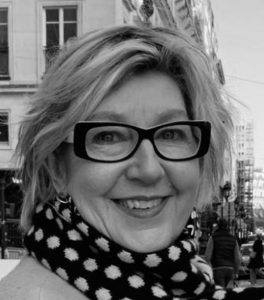
Professor Debbie Flowerday was born in London, England, and has worked in the visual merchandising industry for many years; her knowledge and experience of the Visual Merchandising industry is extensive, and what she enjoys the most is sharing her knowledge with creative students. She shares with us today the top 5 needed to be a great Visual Merchandiser.
1-Branding
It is all about the brand. Visual Merchandisers have a responsibility to create windows that can best compliment the brand.
2-Creativity
The ability to create something from nothing. The ability to see the potential in any given merchandise for arrangement.
3-Imagination
It is important to know how to come away from what is normal, and push boundaries with creative window schemes.
4-Styling
In this case we are talking about styling for more than two mannequins, creating color cohesion, and the ability to mix textures and patterns.
5-Prop Design
The ability in prop making is essential, it is important to know how to sketch or create 3D or Cad window schemes to present to your clients.
What Makes a Powerful Fashion Brand?
In fashion, one of the most important assets of any company is its brand. Creating brand value is essential to achieve a good market position. To do this, brands have to go beyond their traditional functions, product identification and differentiation, and they have to extend above and beyond to connect with consumers. Their functions should also include:
Guarantee
The brand turns into what makes the consumer identify the product as high quality. For this, of course, the product must be of good quality.
Practicality
The brand must provide the necessary information for the consumer to make it ease the purchasing process.
Characterization
The brand must have its own values and identity that allows for a community to form.
Continuity
The brand must be perceived as something that stays and flows through the years.
Ethics
Very important for today’s consumers, today companies also have to make sure their brands are ethical in practices
Brands go beyond their external features, they need teams that understand this and the demands of the market. Do you want to work in Marketing and Communications for Fashion and Luxury brands? Click here and learn more about our program!
What is the Difference between Interior Design and Decoration?
Aesthetics, practicality, liveability, are all aspects taken into account by the Interior Designer. Although decoration plays an important role in interior design, this art goes beyond only aesthetic aspects. Let’s take a closer look at the differences between both.
In interior design there has to be a balance between aesthetics and also the practical of living in a home. The functionality of the space is a very important aspect to meet the needs of the client. For this reason, there is a background work in evaluating the space in terms of advantages and disadvantages, in order to also look if the space requires changes in the distribution. Meaning the first step is always to analyze the architecture of the space, and alter it, if needed. The next step then is the aesthetics of the space, making it just a part of the process of an interior design project.
On the other hand, in decoration, professionals are “dressing up” a space that is already determined and designed. The decorator examines the environment and analyzes everything that is already in existence in the space, and then they reorganize it according to their style.
In conclusion, both decoration and interior design take into account how to make the space as aesthetically appealing as possible, but they have different processes. Nevertheless, both areas are very closely related as an understanding of both is needed for the professional specialized in either field.
